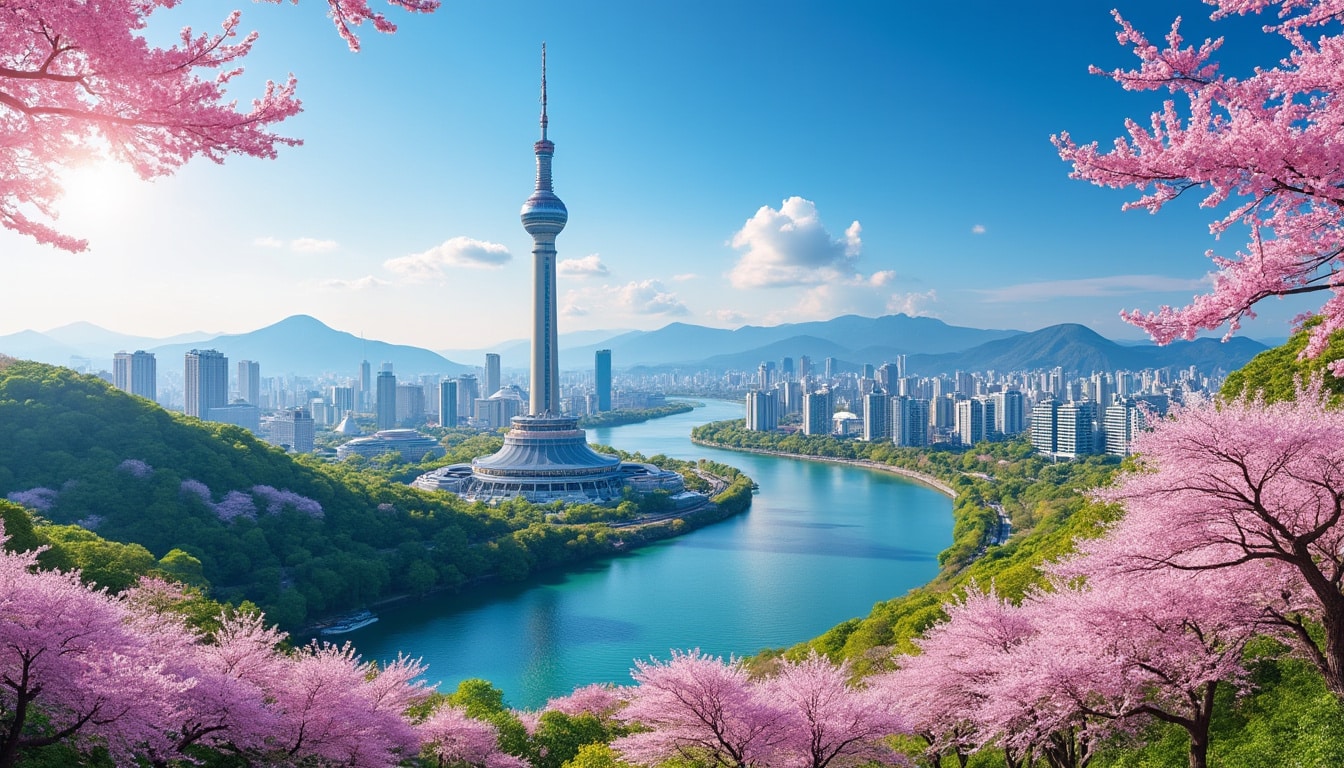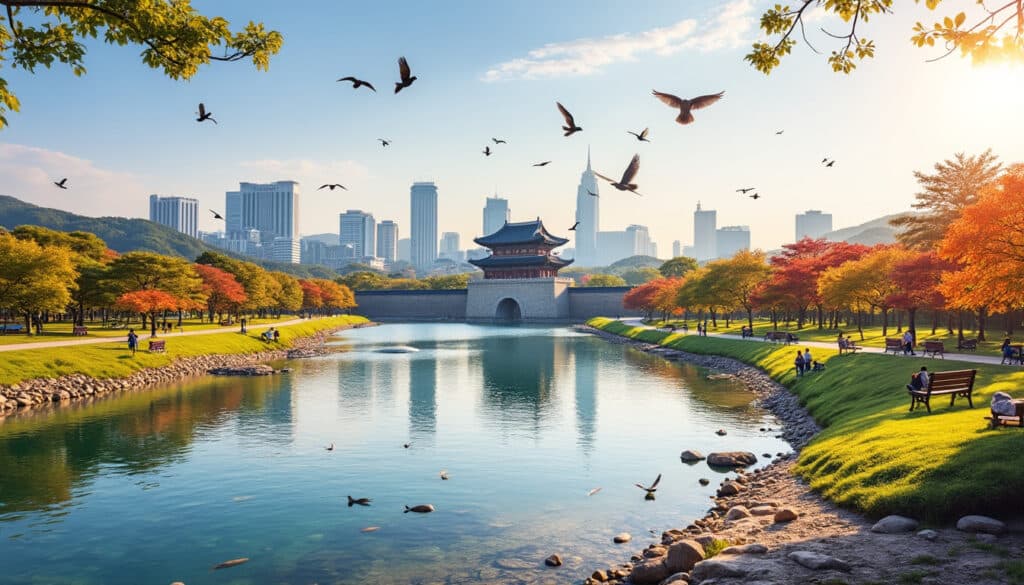Seoul, the vibrant capital of South Korea, is a fascinating blend of modernity and tradition, nestled amidst a diverse and compelling natural landscape. Known for its bustling city life, Seoul offers more than just its skyscrapers and neon lights. The city’s unique geographical features, from its surrounding mountains to its vast water bodies, have significantly shaped its history, culture, and lifestyle. Understanding the nature and geography of Seoul provides invaluable insight into why this city remains a pivotal locale in the Asian continent.
The Mountainous Landscape of Seoul
The landscape of Seoul is profoundly influenced by its mountainous terrain. With over 100 mountains surrounding the city, including the notable Bukhansan National Park and Namsan Mountain, these natural formations have been pivotal in shaping Seoul’s history and culture.
For centuries, the mountains have served as natural fortifications. The ancient Seoul city walls, which can be traced along the ridges of Baegaksan, Naksan, Namsan, and Inwangsan, illustrate how these natural barriers were strategically utilized for defense. This historical significance aligns with the characterization of Seoul as a “fortress city,” where its geographical features played a crucial role in protecting its inhabitants from external threats.
Living in such a terrain means that residents incorporate physical activity into their daily lives, whether they are casually hiking up Namsan Mountain for a panoramic view of the city or exploring the rugged trails of Bukhansan National Park. These mountains provide not just a natural sanctuary away from urban life but also a communal space where people engage in recreational activities, fostering a culture of outdoor exploration.
- 🏞️ Bukhansan National Park: A haven for diverse flora and fauna, offering hiking trails for all skill levels.
- ⛰️ Namsan Mountain: Known for its famous Seoul Tower, Namsan is a popular spot for locals and tourists alike.
- 🗻 Inwangsan: Offers stunning views and is known for its mystical rock formations.
The integration of these natural elements into urban life also presents challenges. The steep terrains lead to a unique urban layout; buildings and roads often adapt to the hilly landscape. Everyday travel can involve navigating the city’s notorious stairs and inclines. Despite these challenges, the mountains remain a cherished aspect of Seoul’s geographical identity, blending seamlessly with the city’s bustling life.
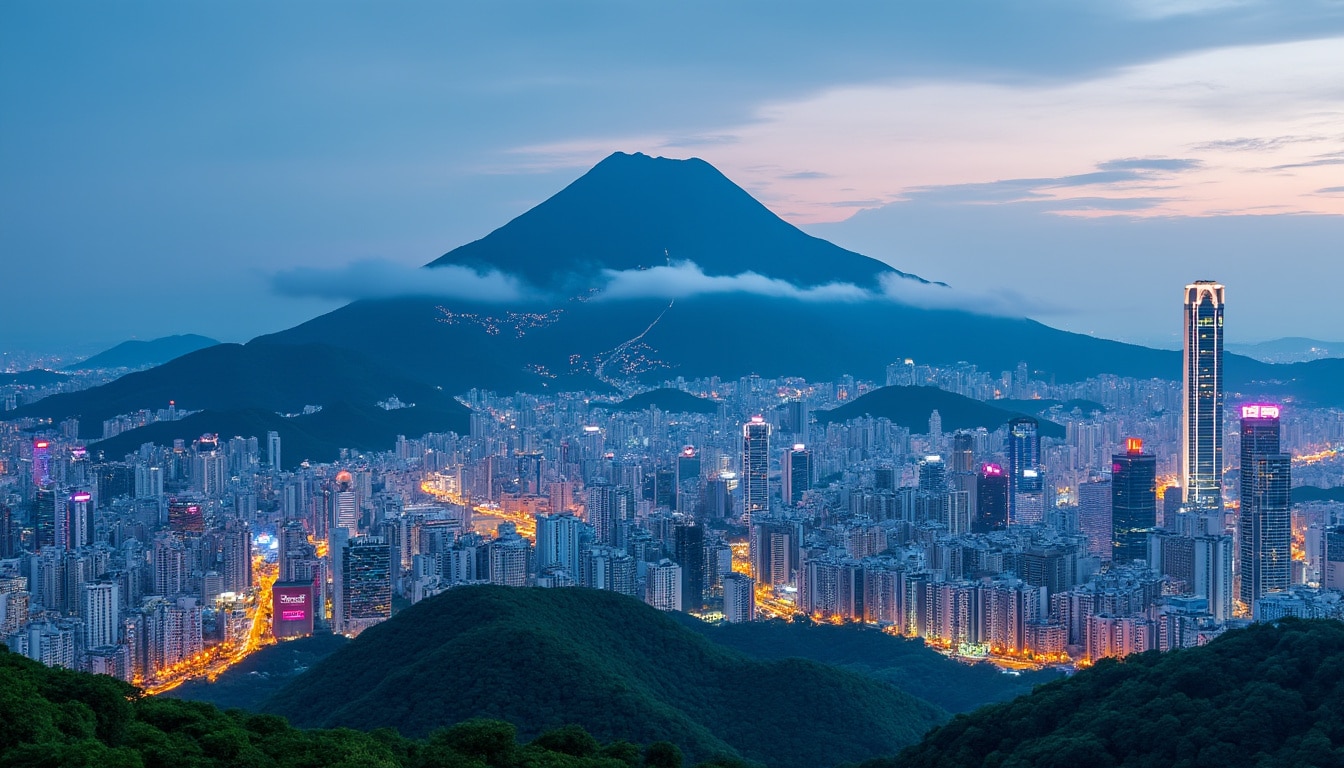
The Vital Role of the Han River
Flowing majestically through the heart of Seoul, the Han River is more than just a body of water. It is an essential element of Seoul’s nature and geography, acting as a lifeline that sustains the city’s ecological balance and serves as a focal point for community activities.
This expansive river bisects the city into northern and southern sections, influencing the city’s layout and development. The Han River, with its enormous width of approximately 1,200 meters, is pivotal for the city’s water supply, supporting both the ecosystem and human activities. Historically, the Han River has been a significant waterway for trade and transportation, contributing to Seoul becoming a prosperous metropolis.
- 🚤 River Cruises: Popular for sightseeing and experiencing city lights reflected on the water.
- 🏊 Water Sports: The river supports a variety of recreational water activities, including boating and kayaking.
Along its banks, numerous parks and recreational areas like the iconic Olympic Park are developed, providing breathing spaces for the city’s residents. These areas are perfect spots for picnics, jogging, and leisurely strolls, enhancing the quality of life for those residing in this bustling urban center.
The Han River also plays a role in cultural and social aspects. Annual festivals and events along its banks attract thousands, creating communal experiences that showcase the harmonious blend of natural beauty and urban culture. However, managing such a significant natural resource within a densely populated city requires continuous efforts in environmental conservation and sustainable urban development to tackle issues like water pollution and ecosystem preservation.
Seoul’s Urban Oasis: Parks and Green Spaces
Despite Seoul’s reputation as a bustling metropolis, the city is interspersed with numerous parks and green spaces that offer residents and visitors a respite from city life. Introducing these green areas has been a conscious effort to blend nature with urban development, ensuring that residents have access to recreational areas that support well-being and community engagement.
The Seoul Forest, a vast ecological park, is a prime example of this urban planning. It consists of several themed parks, offering diverse experiences from eco-learning centers to insect gardens. It serves as a green lung for the city, improving air quality and providing habitats for various wildlife species.
- 🌳 Seoul Forest: A multifaceted park offering eco-zones, art spaces, and tranquil walking paths.
- 🌿 Olympic Park: Beyond sports facilities, it features extensive walking trails and historical sites.
- 🍂 Namsan Park: Surrounding Namsan Mountain, it provides cultural and recreational activities amidst rich greenery.
Seoul’s commitment to green spaces is further demonstrated by areas like Cheonggyecheon Stream. This modern public recreation space is a testament to Seoul’s transformation efforts, where an old highway’s removal allowed a natural waterway to flourish, enhancing both biodiversity and urban aesthetics.
Moreover, these spaces support a multitude of community activities, from yoga classes in the park to weekend farmers’ markets, emphasizing the importance of these areas in fostering social interactions. They also play a crucial role in urban sustainability, aiding in temperature regulation and serving as buffer zones to reduce urban noise.
Historical and Cultural Geography of Seoul
Seoul’s geography isn’t just defined by its physical attributes but also by its rich historical and cultural landscape. Landmarks like the Gyeongbokgung Palace, situated against a mountainous backdrop, remind one of Seoul’s imperial past. The palace, once the heart of the Joseon Dynasty, is a gem of Korean architecture and offers insight into the country’s royal history.
Similarly, experiencing places like Bukchon Hanok Village and Insa-dong allows one to step back in time. These neighborhoods preserve traditional Hanok-style houses and cultural sites, offering a glimpse into Korea’s past. In these areas, the streets are narrower, and the architecture reflects a time when urban planning was deeply intertwined with natural features.
- 🏯 Gyeongbokgung Palace: A royal palace with a rich history and regular cultural performances.
- 🏠 Bukchon Hanok Village: Known for its narrow alleyways and traditional houses.
- 🎨 Insa-dong: A cultural district famous for traditional crafts and tea houses.
Seoul’s historical landmarks are not just tourist attractions; they are enduring symbols of the city’s resilience and ability to adapt through centuries of change, from the Three Kingdoms era to modern times. These sites foster a deeper understanding of Seoul’s identity, where ancient traditions coexist with contemporary lifestyles.
Ecological Challenges and Environmental Efforts in Seoul
Managing Seoul’s diverse geography comes with its ecological challenges, particularly concerning environmental sustainability in a rapidly expanding city. Issues such as air quality, traffic congestion, and pollution present significant challenges, but the city has implemented various efforts to overcome these obstacles.
Seoul’s government has been proactive in its environmental initiatives. The introduction of extensive bicycle lanes and eco-friendly public transportation systems helps reduce carbon footprints. Additionally, green building standards are enforced to ensure energy efficiency in new developments.
- 🚴♂️ Bicycle Lanes: Promoting eco-friendly travel and reducing traffic.
- 🌱 Green Buildings: Incentivizing sustainable construction practices.
- 🚇 Eco-friendly Public Transport: Expanding subway networks with a focus on efficiency.
Moreover, rehabilitation projects, such as those involving the Cheonggyecheon restoration, illuminate how once-abandoned areas can be transformed into vibrant urban spaces, emphasizing both historical preservation and ecological renewal. These efforts reflect a comprehensive approach to urban planning, integrating natural elements to preserve Seoul’s rich ecological tapestry.
The city’s dedication to sustainability and environmental consciousness remains a critical facet of its development strategy, aiming to ensure that Seoul continues to thrive without compromising its natural heritage or the well-being of its inhabitants.
Frequently Asked Questions
- What are the must-visit mountains in Seoul? — Bukhansan, Namsan, and Inwangsan are highly recommended for breathtaking views and trails.
- Is the Han River suitable for water activities? — Yes, the Han River supports various water sports and cruises, offering both adventure and relaxation.
- How does Seoul manage its green spaces? — Through dedicated urban planning that integrates natural parks, public lands, and eco-friendly initiatives.
- Are there efforts to preserve Seoul’s cultural landmarks? — Absolutely, initiatives like restoration projects ensure that historical sites maintain their integrity.
- What environmental challenges does Seoul face? — Key challenges include air pollution, waste management, and maintaining its green spaces amidst urban expansion.
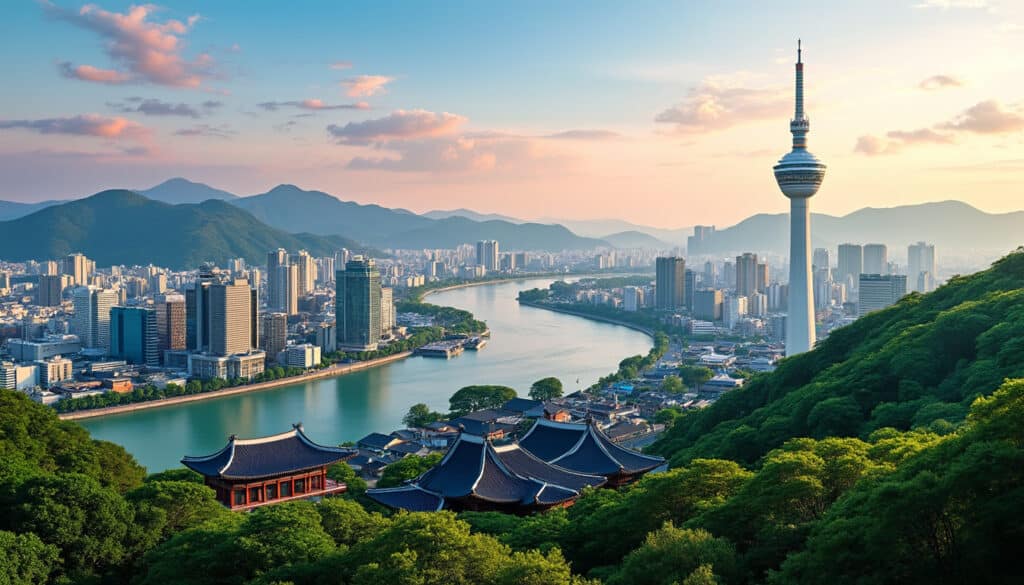
Geographical features of Seoul
Seoul, a city that seamlessly blends the old with the new, offers a unique geographical tapestry that is as diverse as it is fascinating. The bustling capital of South Korea is set against a backdrop of picturesque mountains, nestled beside…
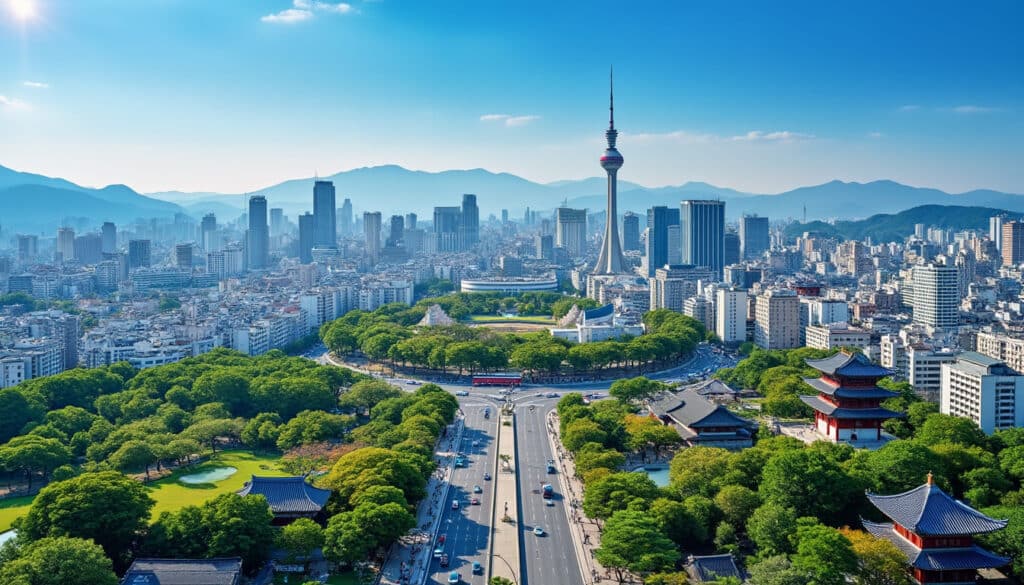
Location and coordinates of Seoul
Seoul, the vibrant capital city of South Korea, is a dynamic metropolis blending ancient traditions with cutting-edge technology. Strategically positioned in Northeast Asia, Seoul’s unique geographic location has played a pivotal role in shaping its development and influence throughout history.…
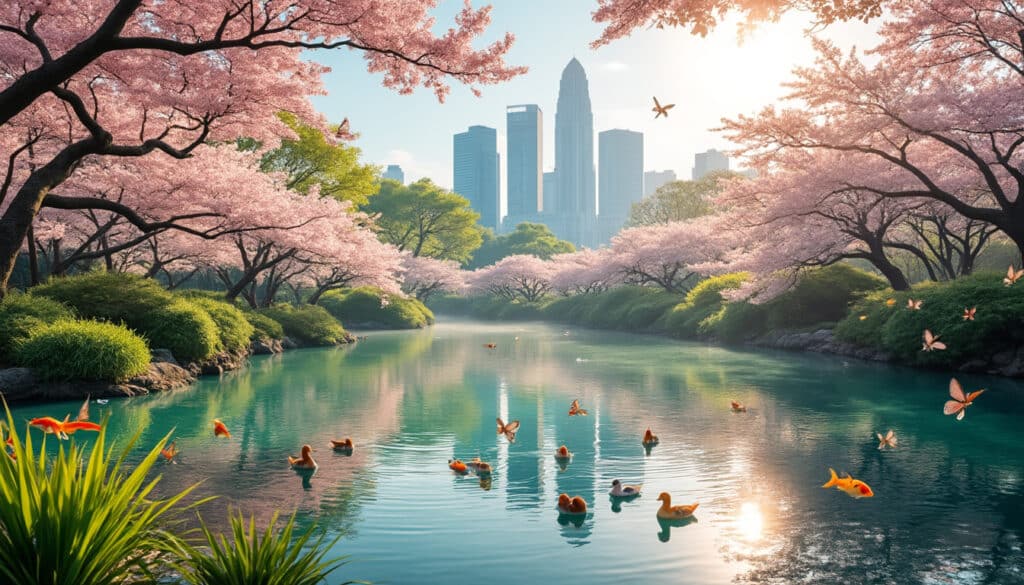
Seoul, a city renowned for its vibrant urban life and towering skyscrapers, also harbors a surprising natural beauty that invites both locals and visitors to take a refreshing step back from the bustling streets. Amidst the blend of modernity, you’ll…

